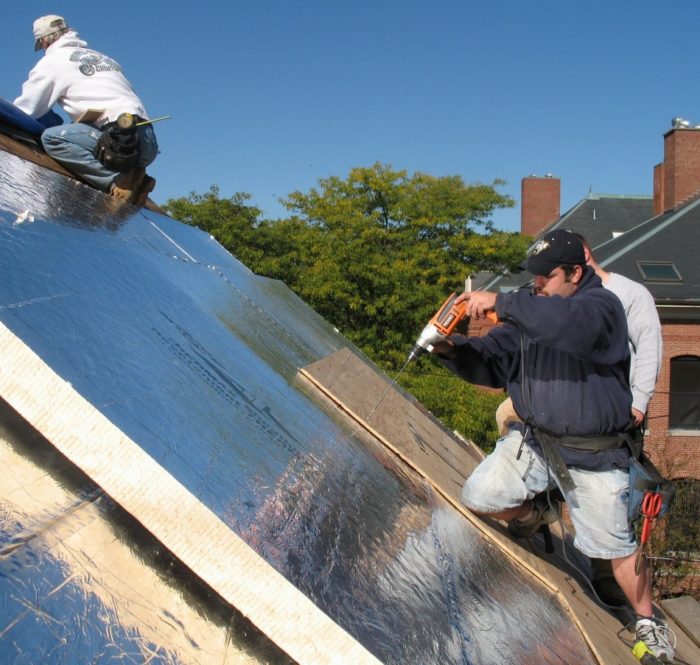
A GBA reader named Leoang is renovating a house in Iowa and thought he had successfully mapped out the details for insulating the roof—until he came across this article warning of the possibility that flame retardants in closed-cell polyurethane foam could off-gas for years.
“I know that there are plenty of VOCs and chemicals on basically everything in a house,” he says in this recent Q&A post. “However, I don’t know if I am willing to expose my little daughter to a known cancer-causing chemical (TCPP).”
His original plan called for a black, standing-seam metal roof over 2×4 furring, a self-adhered roof membrane, 1/2-in. plywood roof deck, and 2×6 rafters. The rafter bays would be insulated with 4 in. of closed-cell foam.
Now, he’s scrambling for alternatives. And they all seem to have shortcomings. The candidates include:
- A 4 1/2-in. layer of extruded polystyrene (XPS) over the roof deck with 5 1/2 in. of mineral wool between the rafters.
- Foil-faced polyiso above the roof deck and mineral wool below.
- Rigid mineral wool above the roof deck and mineral wool below.
The potential problems that Leoang sees are the possibility that the temperatures under the metal roofing would be too much for the XPS: that polyiso does not perform well in cold temperatures; and that a combination of mineral wool batts and panels would make for a very heavy roof.
What’s his best option? That’s the topic for this Q&A Spotlight.
Go for Door Number 2
Akos suggests that Leoang choose his second option—polyiso above the roof deck and mineral wool between the rafters.
“The cold-climate issues with polyiso are overblown in climate zone 5,” he says. “Yes, you lose a bit when it’s very cold but that is only a small portion of the year. You can…
Weekly Newsletter
Get building science and energy efficiency advice, plus special offers, in your inbox.

This article is only available to GBA Prime Members
Sign up for a free trial and get instant access to this article as well as GBA’s complete library of premium articles and construction details.
Start Free TrialAlready a member? Log in











3 Comments
Good discussion. The one thing I disagree with is Josh's description of the underlayment as the primary bulk water control layer. Just like the WRB on walls, the underlay is for incidental moisture from condensation or leaks. Mechanically fastened ones do the job fine.
(This is Josh replying)
I suppose the term 'primary' may be confusing here, but the idea is that when determining where a control layer is in an assembly it is good to determine the 'control layer of concern' for lack of a better term. Strictly speaking, primary could be used for the bulk water control layer on a roof as it is the first thing that water sees or makes contact with. That said, I would consider this first material the water shedding layer-- same thing with the cladding over the WRB. One definitely doesn't want a lot of water getting through the underlayment or WRB so this is the control layer of concern as it has the susceptible parts right behind it. This is often seen and especially pronounced on commercial flat roofs. Oftentimes when the roofing and insulation is pulled or replaced there is standing water below it as 'barrier systems' (or 'barrier walls') are more of a concept than a practical thing. In the case of the commercial roof, the underlayment (and if done right, the drain connection) is clearly the important 'primary bulk water control' layer. The same concept should be applied to residential situations.
When drawing the control layers on the plan set and determining where they are and how they are comprehensive and continuous, one must make a determination as to which one is the one you will hang your reputation on. One should detail the flashings to the roofing underlayment, i.e. the step flashing, kick out flashings and eave flashings-- not the roofing itself. Same goes on the vertical parts of the building, aka, siding. The area of concern is the underlayment, WRB and the associated flashings, therefore labeling it as such is an important heuristic so installers, GC's, QC professionals, inspectors and clients can know what is ultimately protecting their buildings from air, water and heat.
Josh,
Thanks for the reply and explanation.
When talking about walls, our code characterizes the distinction as being between the "First and Second Planes of Protection", and lays out what functions each is expected to perform. Part of what motivated my post is there seems to be a trend towards relying on the WRB or underlayment to perform tasks we usually left to the siding or roofing material. So on walls we have open-cladding systems that are not designed to stop bulk water from entering the cavity behind, and roofs are being detailed with drainage paths on the underlay.
I guess we have a fundamentally different way of looking at these assemblies. I think The First Plane of Protection should be detailed as a complete answer to moisture problems, both bulk water intrusion and condensation. The second layer should be largely redundant, and only function if something has gone wrong with the outer "shedding" material.
Log in or become a member to post a comment.
Sign up Log in